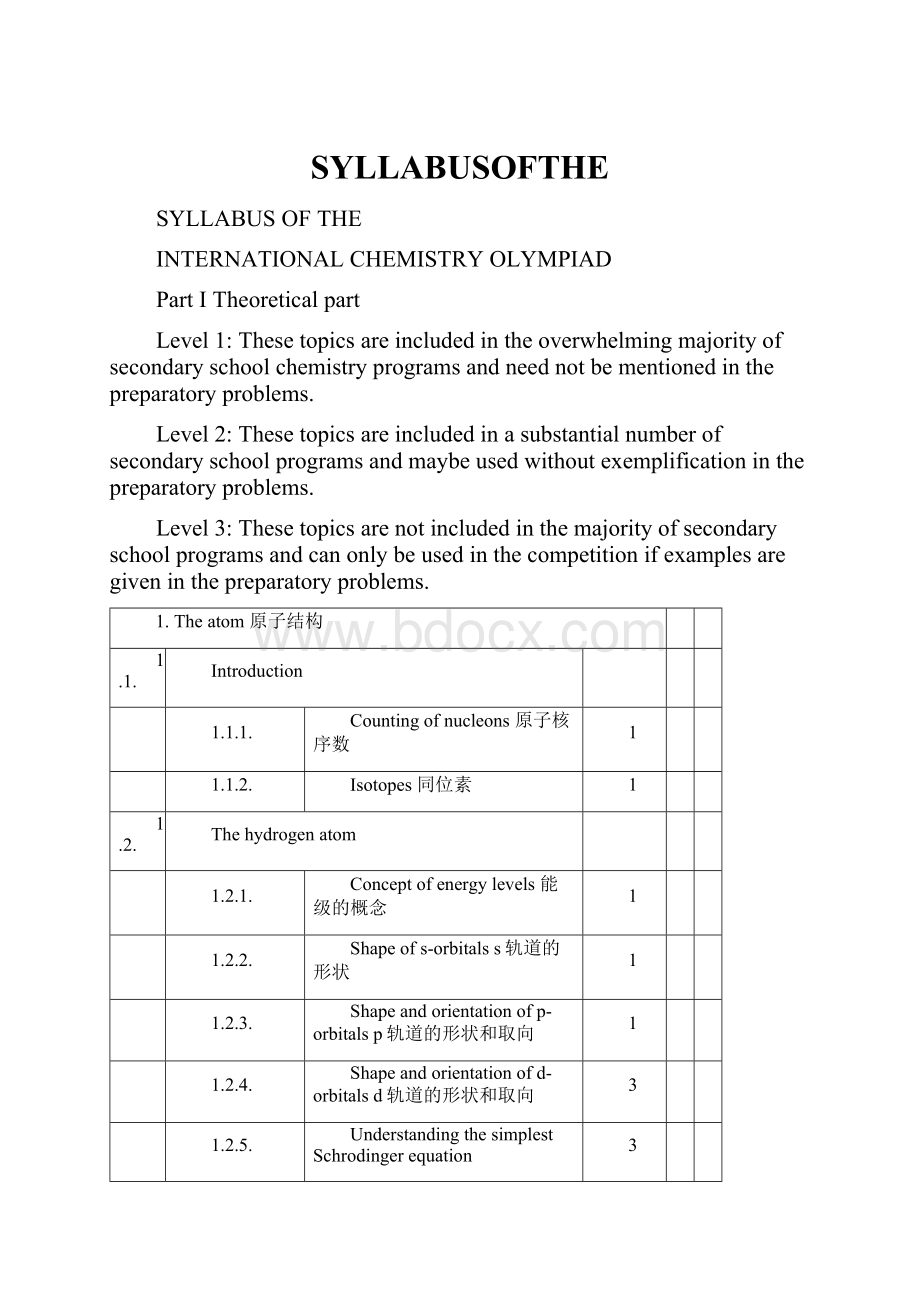SYLLABUSOFTHE.docx
《SYLLABUSOFTHE.docx》由会员分享,可在线阅读,更多相关《SYLLABUSOFTHE.docx(39页珍藏版)》请在冰豆网上搜索。

SYLLABUSOFTHE
SYLLABUSOFTHE
INTERNATIONALCHEMISTRYOLYMPIAD
PartITheoreticalpart
Level1:
Thesetopicsareincludedintheoverwhelmingmajorityofsecondaryschoolchemistryprogramsandneednotbementionedinthepreparatoryproblems.
Level2:
Thesetopicsareincludedinasubstantialnumberofsecondaryschoolprogramsandmaybeusedwithoutexemplificationinthepreparatoryproblems.
Level3:
Thesetopicsarenotincludedinthemajorityofsecondaryschoolprogramsandcanonlybeusedinthecompetitionifexamplesaregiveninthepreparatoryproblems.
1.Theatom原子结构
1.1.
Introduction
1.1.1.
Countingofnucleons原子核序数
1
1.1.2.
Isotopes同位素
1
1.2.
Thehydrogenatom
1.2.1.
Conceptofenergylevels能级的概念
1
1.2.2.
Shapeofs-orbitalss轨道的形状
1
1.2.3.
Shapeandorientationofp-orbitalsp轨道的形状和取向
1
1.2.4.
Shapeandorientationofd-orbitalsd轨道的形状和取向
3
1.2.5.
UnderstandingthesimplestSchrodingerequation
3
1.2.6.
Squareofthewavefunctionandprobability波函数的平方和几率
3
1.2.7.
Quantumnumbers(n,l,ml)
3
1.3.
Radioactivity放射性
1.3.1.
Typesofradioactivity
1
1.3.2.
Radioactivedecay放射性衰变
1
1.3.3.
Nuclearreactions核反应
2
2.Chemicalbonding化学键
2.1.
VSEPR–Simplemolecularstructureswith
2.1.1.
nomorethanfourelectronpairsaboutcentralatom
1
2.1.2.
withcentralatomexceedingthe“octetrule”八隅律
3
2.2.
Delocalizationandresonance离域和共振
3
2.3.
Hybridorbitaltheory杂化轨道理论
3
2.4.
Molecularorbitaltheory分子轨道理论
2.4.1.
molecularorbitaldiagram(H2molecule)
3
2.4.2.
molecularorbitaldiagram(N2andO2molecules)
3
2.4.3.
bondordersinO2,O2–,O2+
3
2.4.4.
unpairedelectronsandparamagnetism未成对电子和顺磁性
3
3.Chemicalcalculations
3.1.1.
Balancingequations
1
3.1.2.
Stoichiometriccalculations
1
3.1.3.
Massandvolumerelations(includingdensity)
1
3.1.4.
Empiricalformula实验式
1
3.1.5.
Avogadro’snumber
1
3.1.6.
Concentrationcalculations浓度计算
1
4.Periodictrends周期律
4.1.
Electronconfiguration电子构型
4.1.1.
Pauliexclusionprinciple
1
4.1.2.
Hund’sRule
1
4.1.3.
Maingroupelements
1
4.1.4.
Transitionmetalelements
1
4.1.5.
Lanthanideandactinidemetals
3
4.2.
Electronegativity电负性
1
4.3.
Electronaffinity电子亲和能
2
4.4.
Firstionizationenergy第一电离能
1
4.5.
Atomicsize
1
4.6.
Ionsize
1
4.7.
Highestoxidationnumber
1
5.InorganicChemistry
5.1.
Introduction
5.1.1.
Trendsinphysicalpropertiesofelements(Maingroups)
5.1.1.1.
meltingpoint
1
5.1.1.2.
boilingpoint
1
5.1.1.3.
metalcharacter
1
5.1.1.4.
magneticproperties
3
5.1.1.5.
electricalconductivity导电性
2
5.1.2.
Oxidationnumber
1
5.1.3.
Nomenclature
5.1.3.1.
maingroupcompounds
1
5.1.3.2.
transitionmetalcompounds
1
5.1.3.3.
simplemetalcomplexes
3
5.2.
Groups1and2一二族
5.2.1.
Trendinreactivityof(heavyelementsmorereactive)
1
5.2.2.
Productsofreactionwith
5.2.2.1.
water
1
5.2.2.2.
Halogens卤素
1
5.2.2.3.
oxygen
2
5.2.3.
Basicityofoxides氧化物的酸碱性
1
5.2.4.
Propertiesofhydrides氢化物的性质
3
5.2.5.
Othercompounds,propertiesandoxidationstates
3
5.3.
Groups13–18andHydrogen
5.3.1.
Binarymolecularcompoundsofhydrogen二元氢化物
5.3.1.1.
Formulae
1
5.3.1.2.
Acid-basepropertiesofCH4,NH3,H2O,H2S
1
5.3.1.3.
Otherproperties
3
5.3.2.
Pblockelementsp区元素
Group13(Borongroup)
5.3.2.1
Theoxidationstateofboron硼andaluminium铝intheiroxides氧化物andchlorides氯化物is+3
1
5.3.2.2.
Theacid-basepropertiesofaluminiumoxide/hydroxide
2
5.3.2.3.
Reactionofboron(III)oxidewithwater
3
5.3.2.4.
Reactionofboron(III)chloridewithwater
3
5.3.2.5.
Othercompounds,propertiesandoxidationstates
3
5.3.3.
Group14(Carbongroup)
5.3.3.1.
TheoxidationstateofSiinitschlorideandoxideis+4
1
5.3.3.2.
The+2and+4oxidationstatesofcarbon,tin锡andlead铅,theacid-baseandredox氧化-还原propertiesoftheoxidesandchlorides
2
5.3.3.3.
Othercompounds,propertiesandoxidationstates
3
5.3.4.
Group15(Nitrogengroup)
5.3.4.1.
Phosphorus磷(+5)oxideandchloride,andtheirreactionwithwater
2
5.3.4.2.
Phosphorus(+3)oxideandchloride,andtheirreactionwithwater
2
5.3.4.3.
Oxidesofnitrogen
a.ReactionofNOtoformNO2
1
b.Dimerization二聚ofNO2
1
c.ReactionofNO2withwater
1
5.3.4.4.
Redoxpropertiesof
a.HNO3andnitrates硝酸盐
1
b.HNO2andNH2NH2
3
5.3.4.5.
Bi(+5)andBi(+3)
3
5.3.4.6.
Othercompounds,propertiesandoxidationstates
3
5.3.5.
Group16(Oxygengroup)
5.3.5.1.
The+4and+6oxidationstatesofsulfur,reactionoftheiroxideswithwater,propertiesoftheiracids
1
5.3.5.2.
Reactionofthiosulfate硫代硫酸根anionwithI2
3
5.3.5.3.
Othercompounds,propertiesandoxidationstates
3
5.3.6.
Group17(Halogens)
5.3.6.1.
Reactivityandoxidant氧化strengthdecreasesfromF2toI2
1
5.3.6.2.
Acid-basepropertiesofthehydrogenhalides卤化氢
1
5.3.6.3.
Theoxidationstateoffluorine氟initscompoundsis–1
1
5.3.6.4.
The–1,+1,+3,+5,+7oxidationstatesofchlorine
1
5.3.6.5.
Mononuclear单核的oxoanionsofchlorine
2
5.3.6.6.
Reactionsofhalogenswithwater
3
5.3.6.7.
ReactionofCl2OandCl2O7withwater
3
5.3.6.8.
Othercompounds,propertiesandoxidationstates
3
5.3.7.
Group18(Raregases)
3
5.4.
Transitionelements
5.4.1.
Commonoxidationstatesofcommontransitionmetals:
Cr(+2),Cr(+3)Mn(+2),Mn(+4),Mn(+7)Ag(+1)
Fe(+2),Fe(+3)Co(+2)Zn(+2)
Hg(+1),Hg(+2)Cu(+1),Cu(+2)Ni(+2)
1
5.4.2.
Coloursofionslistedaboveinaqueoussolution水溶液中的颜色
2
5.4.3.
Insolubility不溶性ofAg,HgandCuinHCl
2
5.4.4.
M2+arisingbydissolutionoftheothermetalsinHCl
2
5.4.5.
Cr(OH)3andZn(OH)2areamphoteric两性的andtheother+2
oxides/hydroxides氧化物和氢氧化物ofthemetalslistedabovearebasic
2
5.4.6.
MnO4–andCr2O72–arestrongoxidantsinacidsolution
1
5.4.7.
pHdependenceofproductsofMnO4–actingasoxidant
2
5.4.8.
InterconversionbetweenCrO42–andCr2O72–
3
5.4.9.
Othercompounds,propertiesandoxidationstates
3
5.5.
Lanthanidesandactinides
3
5.6.
Coordination配位chemistryincludingstereochemistry立体化学
5.6.1.
Definitionofcoordinationnumber
1
5.6.2.
Writingequationsforcomplexationreactionsgivenallformulae
1
5.6.3.
Formulaeofcommoncomplexions
5.6.3.1.
Ag(NH3)2+
1
5.6.3.2.
Ag(S2O3)23–
3
5.6.3.3.
FeSCN2+
3
5.6.3.4.
Cu(NH3)42+
1
5.6.3.5.
Othercomplexions
3
5.6.4.
(6.5)Ligandfieldtheory(egandt2gterms,highandlowspin自旋)
3
5.6.5.
Stereochemistry立体化学
5.6.5.1.
(6.7)cisandtrans
3
5.6.5.2.
Enantiomers对映体
3
5.7.
Selectedindustrialprocesses
5.7.1.
PreparationofH2SO4
1
5.7.2.
PreparationofNH3
1
5.7.3.
PreparationofNa2CO3
2
5.7.4.
PreparationofCl2andNaOH
2
5.7.5.
PreparationofHNO3
2
6.Physicalchemistry
6.1.
Gases
6.1.1.
Idealgaslaw理想气体定律
1
6.1.2.
vanderWaal’sgaslaw范德华气体定律
3
6.1.3.
definitionofpartialpressure分压的定义
2
6.1.4.
Dalton’sLaw道尔顿定律
3
6.2.
Thermodynamics热力学
6.2.1.
FirstLaw热力学第一定律
6.2.1.1.
Conceptofsystemandsurroundings体系和环境
2
6.2.1.2.
Energy,heatandwork
2
6.2.2.
Enthalpy焓
6.2.2.1.
Relationshipbetweeninternalenergyandenthalpy内能和焓的关系
3
6.2.2.2.
Definitionofheatcapacity热容的定义
2
6.2.2.3.
DifferencebetweenCpandCv(idealgasonly)
3
6.2.2.4.
Enthalpyisastateproperty(Hess’sLaw)
2
6.2.2.5.
Born-Habercycleforioniccompounds离子化合物
3
6.2.2.6.
Useofstandardformationenthalpies
2
6.2.2.7.
Enthalpiesofsolutionandsalvation溶解/稀释焓
3
6.2.2.8.
Bondenthalpies(definitionanduse)键焓
2
6.2.3.
SecondLaw(EntropyandFreeEnergy)
6.2.3.1.
Entropydefinition(dq/T)熵的定义
3
6.2.3.2.
Entropyanddisorder熵和混乱度
3
6.2.3.3.
Entropydefinition(S=klnW)熵的定义
3
6.2.3.4.
Gibbsenergydefinition(∆G=∆H–T∆S)
3
6.2.3.5.
Using∆Gtopredictdirectionofnatural自发change
3
6.2.3.6.
Relationshipbetween∆G︒andequilibriumconstantK
3
6.3.
Equilibrium平衡
6.3.1.
Acid-base酸碱平衡
6.3.1.1.
Arrheniusdefinitionsofacidsandbases
1
6.3.1.2.
Bronsted-Lowrydefinitions
1
6.3.1.3.
Conjugateacidsandbases
1
6.3.1.4.
pHdefinition
1
6.3.1.5.
Kw